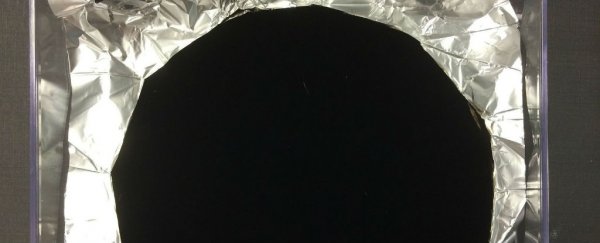
Back in 2014, a team of British researchers made headlines for producing the blackest material known to science. Called Vantablack, the material was so black, it absorbed all but 0.035 percent of visible light, which means to our eyes, it was borderline invisible. Now the blackest material ever made is even more black, with the inventors announcing that no spectrometer in the world is powerful enough to measure how much light it absorbs.
So far, all we know about this record-breaking material is what's in the video above, filmed by the Vantablack inventors at Surrey NanoSystems just moments after they removed it from the reactor.
"It's resulted in a coating so black that our spectrometers can't measure it!" the team explains. "Even running a high power laser pointer across it barely reflects anything back to the viewer. We have never before made a material so 'black' that it can't be picked up on our spectrometers in the infrared."
So what exactly is Vantablack? While it might look like it, Vantablack isn't a paint, pigment, or fabric, but is actually a special coating made from millions of carbon nanotubes, each one measuring around 20 namometres - approximately 3,500 times smaller than the diameter of a human hair - by 14 to 50 microns. To put that in perspective, 1 nanometre equals 0.001 microns.
According to Surrey NanoSystems, a surface area of just 1 cm squared would contain around 1,000 million of these nanotubes.
When light hits this arrangement, it enters the gaps between the nanotubes and is almost instantly absorbed as it bounces between them and can't escape. "The near total lack of reflectance creates an almost perfect black surface," say the researchers. "To understand this effect, try to visualise walking through a forest in which the trees are around 3 km tall instead of the usual 10 to 20 metres. It's easy to imagine just how little light, if any, would reach you."
If that analogy set your imagination into overdrive, you're not the only one - the world's blackest material is set to revolutionise art, with internationally acclaimed sculptor Sir Anish Kapoor telling the BBC that a space coated in Vantablack would be unnerving, to say the least. "Imagine a space that's so dark that as you walk in, you lose all sense of where you are, what you are, and especially all sense of time," he said.
The only problem is that over the weekend, Kapoor announced that he's bought the exclusive rights to use Vantablack in his art, and other artists are not happy.
Now, in case you're still not convinced of the blackest black material's blackness, here's Vantablack's record-breaking blackness compared to other shades of black:

H/T: SPLOID
